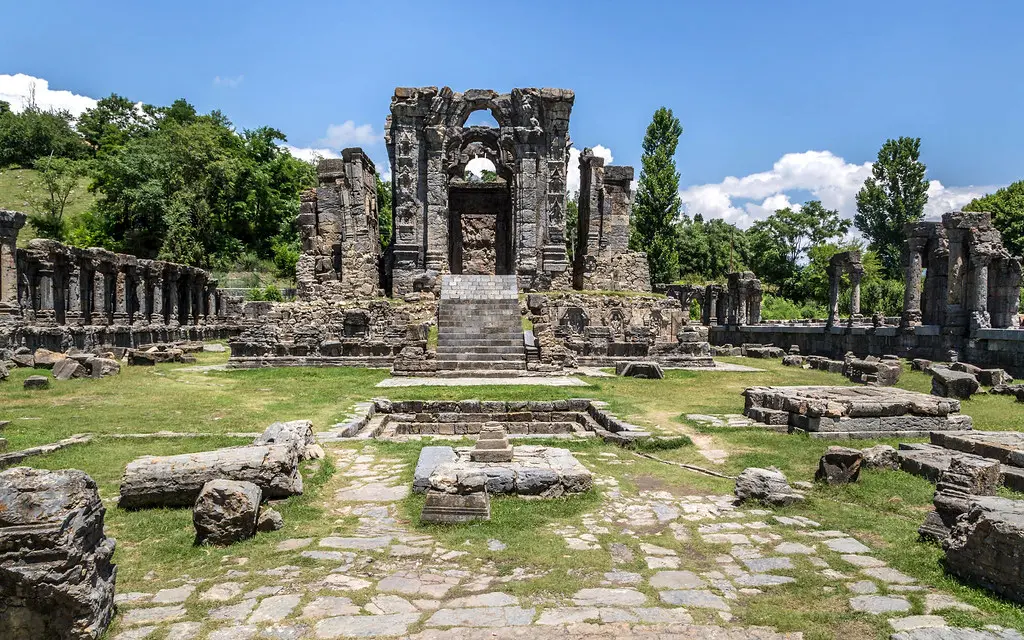List of Masjids in Kashmir which was built by destroying Hindu temples
LIST OF MOSQUES IN KASHMIR WHICH WERE BUILT AFTER DEMOLISHING THE HINDU TEMPLES
We give below, state-wise and district-wise, the particulars of Muslim monuments which stand on the sites and/or have been built with the materials of Hindu temples, and which we wish to recall as witnesses to the role of Islam as a religion and the character of Muslim rule in medieval India. The list is the result of a preliminary survey. Many more Muslim monuments await examination. Local traditions which have so far been ignored or neglected have to be tapped on a large scale.
We have tried our best to be exact in respect of locations, names and dates of the monuments mentioned. Even so, some mistakes and confusions may have remained. It is not unoften that different sources provide different dates and names for the same monument. Many Muslim saints are known by several names, which create confusion in identifying their mazars or dargahs. Some districts have been renamed or newly, created and a place which was earlier under one district may have been included in another. We shall be grateful to readers who point out these mistakes so that they can be corrected in our major study. This is only a brief summary.
Sita Ram Goel
It should be kept in mind that the list below doesn’t include all the temples destroyed by Muslims and converted to mosques. The below is the list of mosques and Dargahs where evidences exists of having been made after destroying the temples at these locations. In many mosques, Muslim rulers were able to eradicate all signs of temples, and hence not given in below list.
Anyone is free to visit the below list of mosques and see the remnants and materials of Hindu temples used in their construction. Archaeological Survey of India should conduct an excavation of below mosques to find out more about the ancient temples in these locations and possible mass graves around the mosque sites.
Amburher
1. Ziarat of Farrukhzad Sahib. Temple materials used.
Badgam
2. Ziarat of Abban Shah in Ghagarpur. Temple site.
3. Ziarat of Sayyid Swalia Shah in Narbai. Temple site.
Bijbehra
4. Masjid. Temple site.
Bumzu
5. Ziarat of Baba Bamdin. Converted Bhimakesava. Temple.
6. Ziarat of Ruknud-Din Rishi. Converted temple.
7. Ziarat farther up the valley. Converted temple.
Gulmarg
8. Ziarat of Baba Imam Din Rishi. Temple materials used.
Gupkar
9. Ziarat of Jyesther and other monuments. Temple materials used.
Hutmar
10. Jami Masjid. Temple materials used.
Khonmuh
11. Several Ziarats. Temple materials used.
Kitshom
12. Two Masjids. Stand amidst temple ruins.
Loduv
13. Ziarat. Temple materials used.
Lohar
14. Ziarat of Sayyid Chanan Ghazi. Temple site.
Lokbavan
15. Garden Pavilion. Temple materials from Lokabhavana Tirtha used.
Marsus
16. Ziarat of Shah Abdullah. Temple site.
Pampor
17. Ziarat of Mir Muhammad Hamadani. Vishnusvamin Temple materials used.
18. Several other Ziarats. Temple materials used.
Pandrethan
19. Masjid. Meruvardhanaswamin Temple materials used.
Sangar
20. Ziarat. Temple materials used.
Sar
21. Ziarat of Khwaja Khizr. Temple materials used.
Shalmar
22. Garden, Pavilion on the 4th terrace. Temple materials used.
Srinagar
Ancient Hindu city converted into a Muslim capital. The following monuments stand on temple sites and most of them have been constructed with temple materials.
23. Ziarat of Bahaud-Din Sahib. Jayasvamin Temple converted.
24. Graveyard and its Gate below the 4th Bridge.
25. Dargah and Masjid of Shah-i-Hamadani in Kalashpura. On the site of the Kali Temple.
26. Nau or Patthar-ki-Masjid built by Nur Jahan.
27. Graveyard near the Nau Masjid.
28. Ziarat of Malik Sahib in Didd Mar. On the site of Didda Matha.
29. Masjid and Madrasa and Graveyard near Vicharnag. On the site and from materials of the Vikramesvara Temple.
30. Madni Sahib-ki-Masjid at Zadibal.
31. Ziarat south-west of Madni Sahib-ki-Masjid.
32. Jami Masjid originally built by Sikandar Butshikan and reconstructed in later times.
33. Ziarat named Nur Pirastan. Narendrasaamin Temple converted.
34. Maqbara of Sultan Zainul-Abidin.
35. Maqbara of Zainul-Abidins mother, queen of Sikandar Butshikan.
36. Ziarat of Pir Haji Muhammad Sahib, south-west of the Jami Masjid. Vishnu Ranasvamin Temple converted.
37. Ziarats of Makhdum Sahib and Akhun Mulla on Hari Parbat. Bhimasvamin Temple converted.
38. Masjid of Akhun Mulla built by Dara Shikoh.
39. Ziarat of Pir Muhammad Basur in Khandbavan. On the site of Skandabhavana Vihara.
40. Graveyard north-east of Khandbavan.
41. Dargah of Pir Dastgir.
42. Dargah of Naqshbandi.
43. Ramparts and Kathi Gate of the Fort built by Akbar.
44. Stone embankments on both sides and for several miles of the Jhelum river as its passes through Srinagar.
45. Astana of Mir Shamsud-Din Syed Muhammad Iraqi.
Sudarbal
46. Ziarat of Hazrat Bal. Temple site.
Tapar
47. Bund from Naidkhai to Sopor built by Zainul-Abidin. Materials from Narendresvara Temple used.
Theda
48. Ziarat near Dampor. Temple materials used.
Vernag
49. Stone enclosure built by Jahangir. Temple materials used.
Wular Lake
50. Suna Lanka, pleasure haunt built by Zainul-Abidin in the midst of the Lake. Temple materials used.
51. Dargah of Shukrud-Din on the western shore. Temple site.
Zukur
52. Several Ziarats and Maqbaras. Temple materials used.
EVIDENCE IS AVAILABLE THAT IN KASHMIR THE ABOVE MENTIONED MOSQUES AND DARGAHS WERE CONSTRUCTED BY DESTROYING HINDU TEMPLES. BUT IN MANY OTHER CASES MUSLIMS SUCCEEDED IN REMOVING ALL TRACES OF TEMPLES FROM THE MOSQUES. IN SUCH CASES ONLY AN EXCAVATION BY ASI WILL REVEAL THE DESTROYED TEMPLES.
WHILE MUSLIMS ASK FOR REBUILDING THE ILLEGAL MOSQUE IN AYODHYA, WHY SHOULD NOT HINDUS DEMAND THE RECONSTRUCTION OF THE DESTROYED TEMPLES IN INDIA?
REFERENCE:
1. Hindu Temples: What happened to them by Sita Ram Goel

